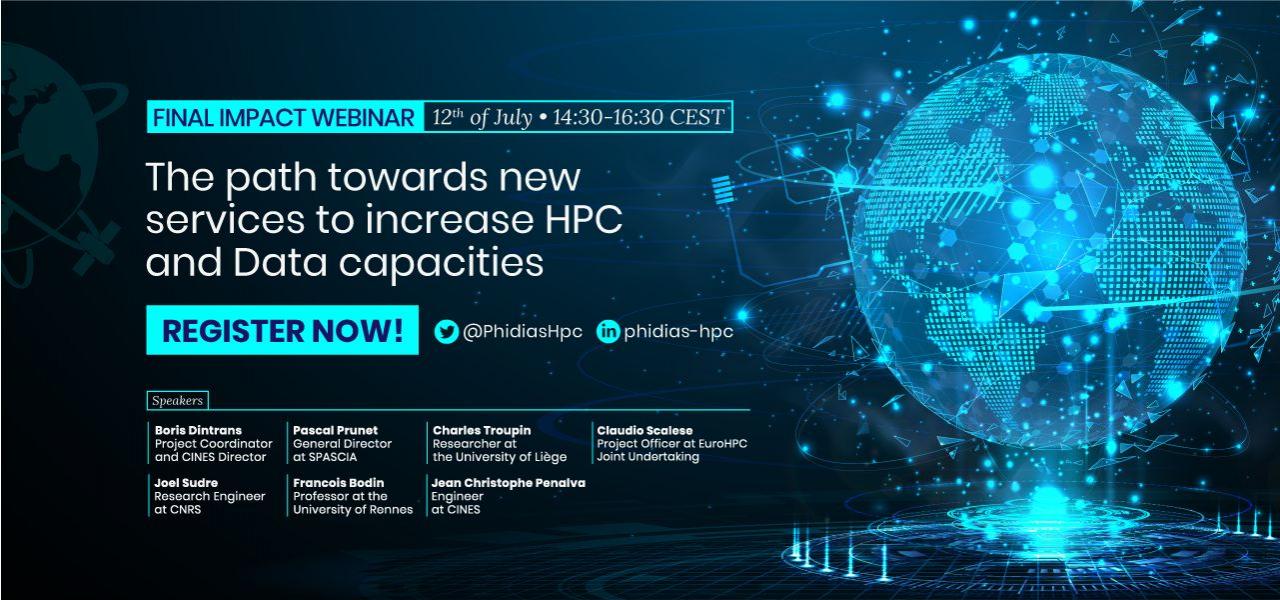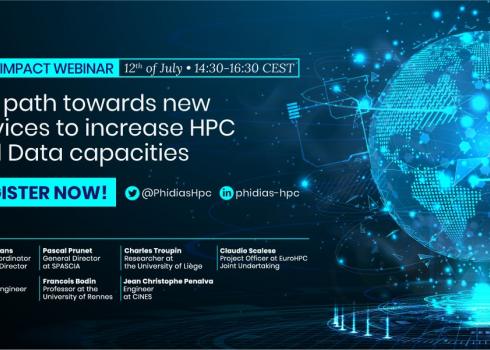Final PHIDIAS Impact Webinar: The path toward new services to increase HPC and Data capacities
Today, many datasets are disseminated, and researchers are not always aware of their existence, their level of quality, and more generally how to access and reuse them for analysis, in combination with their datasets to provide new information and knowledge.
The PHIDIAS project, funded by the European Union’s Connecting Europe Facility (CEF), is built on this framework, aiming to become a reference point for the Earth science community enabling them to discover, manage and process spatial and environmental data, through the development of a set of high performance computing (HPC) based services and tools exploiting large satellite datasets.
After a 36-month journey, this Webinar aimed at presenting the tangible outputs achieved by the PHIDIAS HPC initiative at the service of the European HPC and Research community, including main features, concrete impact, and prospective advantages for the Research & HPC ecosphere, mostly in conjunction with the 4 key pillars of the project:
- Building a prototype for earth scientific data.
- Enabling Open Access to HPC Services.
- Strengthening FAIRisation.
- Creating a framework combining computing, dissemination and archiving resources.
Discovering tangible outputs achieved by PHIDIAS
The webinar was opened by the introductory speech of Boris Dintrans, Director at CINES and PHIDIAS coordinator. Boris explained that PHIDIAS’s overall goal is to build a prototype for Data/High Performance Computing (HPC) services based on Earth sciences cases. He also explained how the project is developing and providing new services to discover, manage and process spatial and environmental data produced by research communities tackling scientific challenges such as atmospheric, marine and earth observation issues.
The webinar then continued featuring the whole project consortium and was moderated by Corentin Lefreve, Project Manager at Neovia Innovation and Project management Officer of PHIDIAS. The first half of the webinar focused on the main advancements of the three Use Cases impacting the Satellite Data, Marine and Ocean data, and Earth Observation research communities, and to share the most meaningful and innovative lessons learned.
The floor then passed to Pascal Prunet, Director at SPASCIA, who highlighted the results that PHIDIAS obtained within the atmosphere Use Case, by using HPC and HPDA capacities and developing screening approaches in an operational context for detection and identification of atmospheric composition events. He also explained the steps forward in detection and identification of atmospheric events from space.
Charles Troupin, Professor at University of Liege, showcased the outcomes of the ocean Use Case. He exhaustively explained the process from millions of data points to a climatology using DIVAnd on the cloud, which then resulted in the seamless access to standardised, quality-controlled datasets. This use case will support scientists to speed up data access, computing, installation/deployment of data analysis in ocean research.
During the webinar, we had the opportunity to host Claudio Scalese, Project Officer at EuroHPC Joint Undertaking, who provided an overview of the next steps of Exascale in Europe. He also highlighted key supercomputers in Europe to be rolled out in the coming months and the eligibility to access them and the overall dynamic HPC ecosystem.
The second half of the webinar tackled the “how to achieve” aspect and the tangible results developed within the project.
Matthieu Bastianelli, Researcher at Geomatys and co-leading the technical development of the project (WP3), explained the PHIDIAS business catalogue and how it is supposed to bridge the gap between users and datasource.
The WP3 set up a business catalogue that allows the discovery of metadata in GEODCAT format, a discovery portal that allows the discovery of data available on the project. He also emphasised that the datasets shared by the WP3 catalogue come from different thematic data infrastructures (Ocean, Land Surfaces, Atmosphere). The catalogue uses a common metadata model (GEODCAT-AP) and a common vocabulary organised by the Sosa ontology (Semantic Sensor Network Ontology) and shared through a thesaurus.
Francois Bodin, Professor at University of Rennes, walked the audience through the vision of the project and the Scientific and End-user committee. This group aims at providing a better understanding of how to mix HPC culture with data culture, and how to better exploit the PHIDIAS findings. He did present observations about overcoming technical and administration constraints and data logistic and compute challenges they addressed to understand what will be the next steps for PHIDIAS, and how the project can help to improve data and computing resource allocation, in order to seamlessly fit in the data and HPC centres.
The last panellist was Jean Christophe Penalva, HPC engineer at CINES, who presented the technical architecture of PHIDIAS around HPC services, where the technical coordination of the project was carried out. He mentioned the open technologies that helped in order to cater the services such as IRODS, notebooks, batch jobs in HPC environment, containers, and portals.
He stressed that “security is very important” when it comes to handling scientific data is critical.
The event ended with the concluding remarks of Boris Dintrans that pointed out how PHIDIAS could help the users of its services, and acknowledged the very engaged participation of the audience, who actively committed and asked questions during the round table sesion. The participation was positive also on social media with live tweeting performed via the official project channel @PhidiasHpc.
Did you miss this webinar? Watch it here!






